cincy_kid
Active member
It's me again!
So, it has been almost a year and we finally got our home office moved from the basement to upstairs. This now frees up our old office space for me to expand my studio.
For those who remember I was exploring different ways to have my studio set up. First off here is a diagram of the current space layout:

This was posted in my last Studio thread which you can read (if you like) here: https://homerecording.com/bbs/showthread.php?t=197282
There were some good ideas/suggestions from Peritus, Panda and others, and thanks again for the suggestions. I am putting this back out there to get more comments in addition to some changes from the last plan. Here are some topics I would like to discuss / ask advice on:
(Comment on any or all of the following topics. Any advice or suggestions are greatly appreciated)
Treatment Overview
I have been reading a lot lately on Ethan's site(s), various forums, articles etc and to be honest am probably on information overload status but as far as treating my rooms I wanted to ask some general questions. First off in the control room, I am going to use the proper formulas for setting up the correct way, in the right position and take care of early reflections.
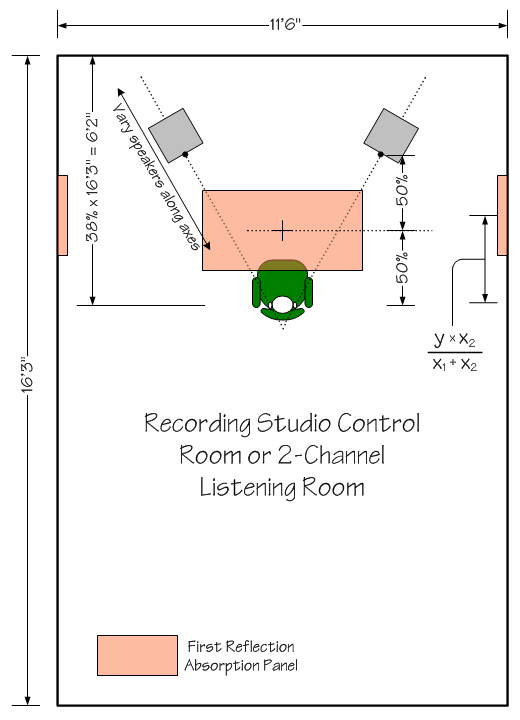
Is there some general rule of thumb thing that you should do before doing any treatment at all? I mean I have never mixed in this room yet and have no idea what it sounds like. Should I first mix in it with no treatment at all to see how live/dead it is and then add/subtract treatment as I go? or should I still follow the general rules of early reflections, bass traps, etc? I just dont want to add a bunch of stuff and then have a completely dead room...(or do I?)
As far as the live room, pretty much the same question. I am going to have some broadband absorbers that I can place on the walls and/or corners. I will also be using the same principle as Ethan's Portable Vocal Booth for vocals as well as the guitar amp. Should I record some first and then add treatment as I see the need for more?
CounterTops
In my last thread I said the countertops couldn't be touched but now I have the choice of ripping them out completely. I could also leave them installed and even add another one to the left as Panda had suggested in my last thread. If I left them in, I was thinking I could hang some fabric from them to hide what's underneath and use it as a storage area for gear or whatever. On the other hand I am also thinking ripping them out would give me more space for other things.
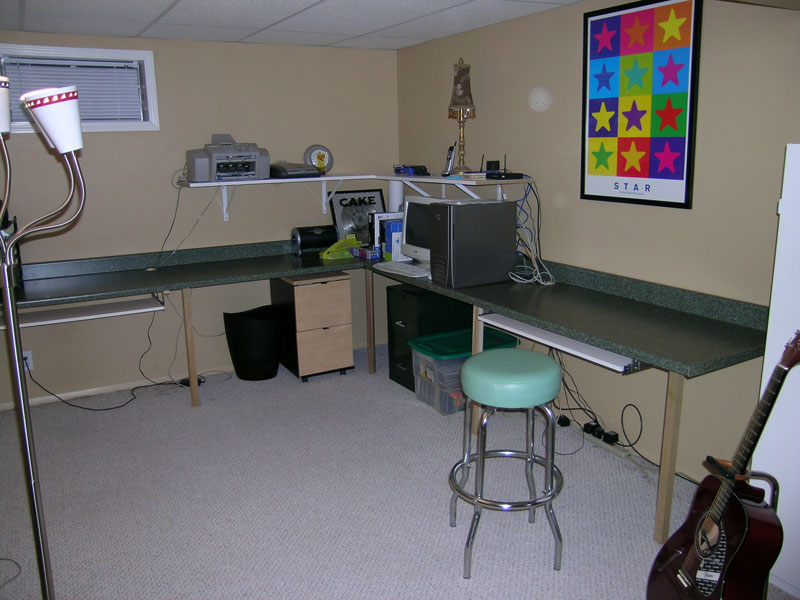
Ceiling
I have a drop ceiling in both the live and control room space. I had planned on hanging a cloud in the proper position in the control room to handle early reflections. If I do, can it be done with the drop ceiling? What i mean to say is, can the drop ceiling support the 15-30 lbs of continual strain of the cloud in addition to any other panels that may need to be hung? I also read where you could simply put the pink style fiberglass up inside the drop ceiling in bundles which could do the trick. If you do this method, do you still keep the tiles in place or remove them, replacing the tiles with a breathable fabric? Keeping the tiles in place seems like it would be pretty reflective. I am looking for suggestions in this area as well (ceiling treatment). Same question in the live room. Should I throw some fiberglass up in the drop ceiling as well?
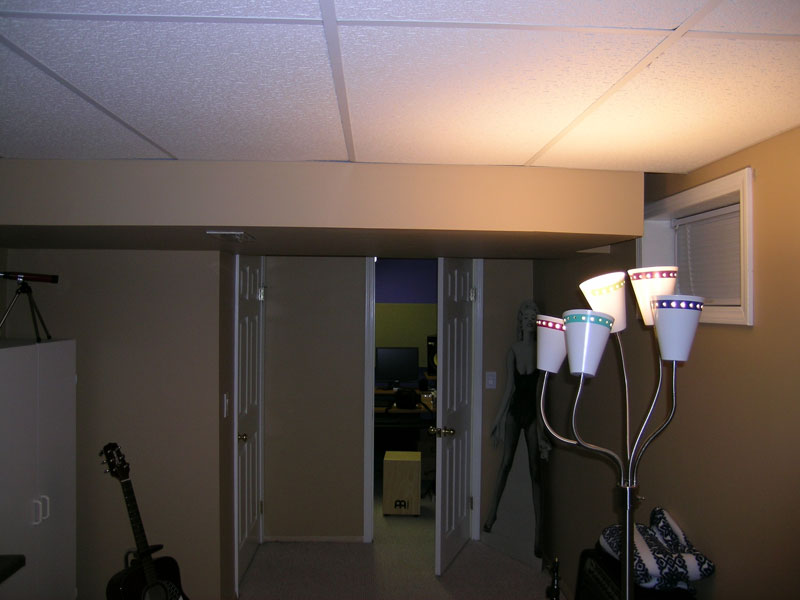
Absorption Panels
Currently I have 4" thick 703 panels 2x4. I have been using the 3 that I have completed as broadband absorbers when I mixed and recorded in the same room. From everything I have read, it seems that on the early reflection points, you want to use 1" or 2" thick 703. Will it hurt for me to use the 4" stuff I already have? I am going to need to buy more of whatever material I use, so I can always buy some 1" or 2" stuff if that will help me more. I just want to make sure that is best for the early reflections and also why that would be true. Just because it absorbs mostly high and mids?
Also, the 703 is off the wall a bit (because of the wood frame hanging on the wall), however with the frame being right up against the wall, I am not sure that would classify as an air gap, does it?

Room Shape
As you can see from my diagram above, my control room is not rectangle shape, it has a cutout near the entry way. In my other thread, Peritus had suggested putting a sliding / bi-fold door there using 703 panels which I thought to be a great idea.
A) Would it indeed help if the room was "squared off" with some sort of wall or sliding doorway as suggested?
B) Would using 703 panels across the entire back of the control room in this fashion make the space too dead?
Desk
The desk I have now worked pretty good in my last room because the size of the room was so small that I had no room for monitor stands, and the desk has the raised sides which perfectly fit the monitors on it. Since I have more room now, I was going to use this conference style table as my desk (basically just a flat rectangle table) and set the monitors on some sort of stands behind the desk. I also think this will give me more of the proper space forula as Etahn mentions in the room setup on his acoustics page. Using the otmy current would result in the monitors sitting too close to me I think, considering the larger new room size.
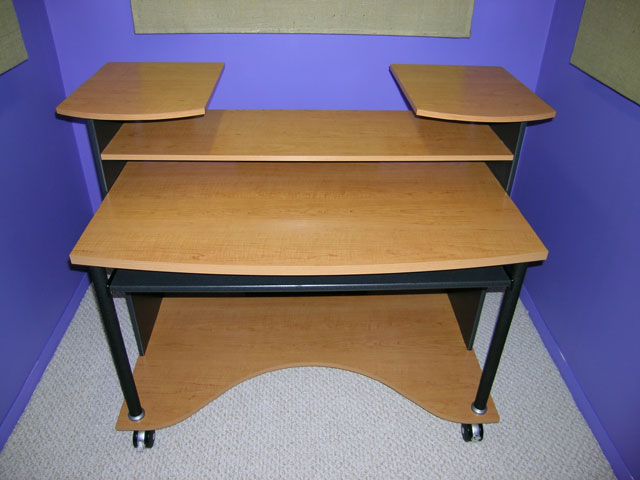
Windows
In the control room area, as you can see from the pictures, there are 3 windows. They all have frames and was thinking of just putting some framed 703 around them. Is this good? bad? other? Anyone have suggestions about the windows?

Lights
In the live room I have one of those long flouresent light fixtures that hangs from the drop ceiling. Early on I had suggestions to take that out and use regular lighitng or faders or something. To be honest I really dont hear the sound being picked up in my mixes, but I am for sure open to doing track lighting or something different in the live room to help set the "mood" (maybe colored lights) and also help with sound reduction.

Work Desk
One caveat in the control room is that I will need to have a small space to work as well. In this picture where the white cabinet looking thing is:
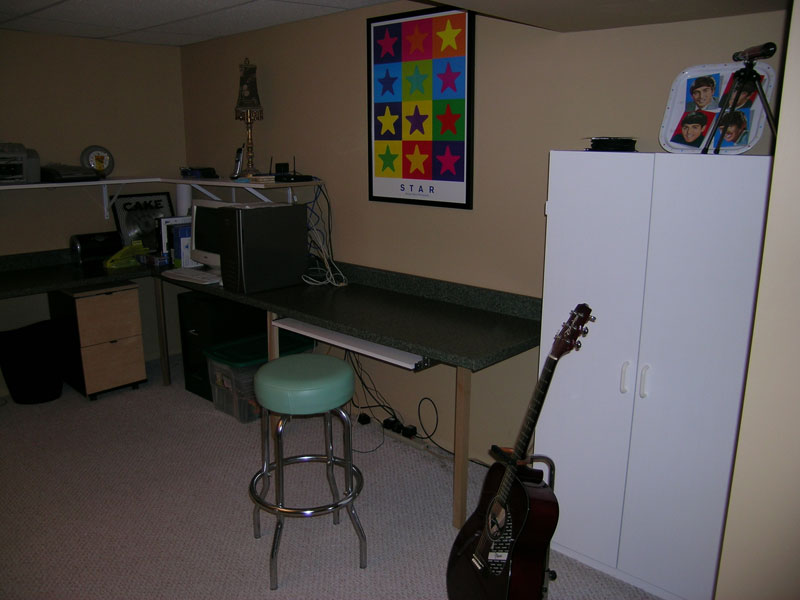
I was thining of putting one of those closing desk things in. Where it looks like a cabinet, but opens to a computer desk during the day for me to do my job:

If I had something in that position, will it affect my mixes etc? Any other suggestions?
Colors
I painted the live room a purple color when I was mixing and recording in the same room:

The new control room space is a light brown color as you can see in the above pictures. I am now toying with re-painting each one or both, maybe none? Any suggestions on good colors and why?
Fabrics
The Panels and traps and other things I will construct will most likely be covered in burlap. I am also considering buying some GOM fabric. Are either one of those fabrics better in regards to being fire retardant? I worry that when I am away and with my computers or anything else on that I will come home one day and my house will be on fire with all of the 703 panels / treatment / burlap being the root of the cause. Should I spray stuff down with the 3M fire retardant spray? WIll that help or is there a better suggestion?
I suppose that is all for now off the top of my head. Are you still readin this??
Thanks in advance for all comments as I am excited to get this project underway!
So, it has been almost a year and we finally got our home office moved from the basement to upstairs. This now frees up our old office space for me to expand my studio.
For those who remember I was exploring different ways to have my studio set up. First off here is a diagram of the current space layout:

This was posted in my last Studio thread which you can read (if you like) here: https://homerecording.com/bbs/showthread.php?t=197282
There were some good ideas/suggestions from Peritus, Panda and others, and thanks again for the suggestions. I am putting this back out there to get more comments in addition to some changes from the last plan. Here are some topics I would like to discuss / ask advice on:
(Comment on any or all of the following topics. Any advice or suggestions are greatly appreciated)
Treatment Overview
I have been reading a lot lately on Ethan's site(s), various forums, articles etc and to be honest am probably on information overload status but as far as treating my rooms I wanted to ask some general questions. First off in the control room, I am going to use the proper formulas for setting up the correct way, in the right position and take care of early reflections.

Is there some general rule of thumb thing that you should do before doing any treatment at all? I mean I have never mixed in this room yet and have no idea what it sounds like. Should I first mix in it with no treatment at all to see how live/dead it is and then add/subtract treatment as I go? or should I still follow the general rules of early reflections, bass traps, etc? I just dont want to add a bunch of stuff and then have a completely dead room...(or do I?)
As far as the live room, pretty much the same question. I am going to have some broadband absorbers that I can place on the walls and/or corners. I will also be using the same principle as Ethan's Portable Vocal Booth for vocals as well as the guitar amp. Should I record some first and then add treatment as I see the need for more?
CounterTops
In my last thread I said the countertops couldn't be touched but now I have the choice of ripping them out completely. I could also leave them installed and even add another one to the left as Panda had suggested in my last thread. If I left them in, I was thinking I could hang some fabric from them to hide what's underneath and use it as a storage area for gear or whatever. On the other hand I am also thinking ripping them out would give me more space for other things.

Ceiling
I have a drop ceiling in both the live and control room space. I had planned on hanging a cloud in the proper position in the control room to handle early reflections. If I do, can it be done with the drop ceiling? What i mean to say is, can the drop ceiling support the 15-30 lbs of continual strain of the cloud in addition to any other panels that may need to be hung? I also read where you could simply put the pink style fiberglass up inside the drop ceiling in bundles which could do the trick. If you do this method, do you still keep the tiles in place or remove them, replacing the tiles with a breathable fabric? Keeping the tiles in place seems like it would be pretty reflective. I am looking for suggestions in this area as well (ceiling treatment). Same question in the live room. Should I throw some fiberglass up in the drop ceiling as well?

Absorption Panels
Currently I have 4" thick 703 panels 2x4. I have been using the 3 that I have completed as broadband absorbers when I mixed and recorded in the same room. From everything I have read, it seems that on the early reflection points, you want to use 1" or 2" thick 703. Will it hurt for me to use the 4" stuff I already have? I am going to need to buy more of whatever material I use, so I can always buy some 1" or 2" stuff if that will help me more. I just want to make sure that is best for the early reflections and also why that would be true. Just because it absorbs mostly high and mids?
Also, the 703 is off the wall a bit (because of the wood frame hanging on the wall), however with the frame being right up against the wall, I am not sure that would classify as an air gap, does it?

Room Shape
As you can see from my diagram above, my control room is not rectangle shape, it has a cutout near the entry way. In my other thread, Peritus had suggested putting a sliding / bi-fold door there using 703 panels which I thought to be a great idea.
A) Would it indeed help if the room was "squared off" with some sort of wall or sliding doorway as suggested?
B) Would using 703 panels across the entire back of the control room in this fashion make the space too dead?
Desk
The desk I have now worked pretty good in my last room because the size of the room was so small that I had no room for monitor stands, and the desk has the raised sides which perfectly fit the monitors on it. Since I have more room now, I was going to use this conference style table as my desk (basically just a flat rectangle table) and set the monitors on some sort of stands behind the desk. I also think this will give me more of the proper space forula as Etahn mentions in the room setup on his acoustics page. Using the otmy current would result in the monitors sitting too close to me I think, considering the larger new room size.

Windows
In the control room area, as you can see from the pictures, there are 3 windows. They all have frames and was thinking of just putting some framed 703 around them. Is this good? bad? other? Anyone have suggestions about the windows?

Lights
In the live room I have one of those long flouresent light fixtures that hangs from the drop ceiling. Early on I had suggestions to take that out and use regular lighitng or faders or something. To be honest I really dont hear the sound being picked up in my mixes, but I am for sure open to doing track lighting or something different in the live room to help set the "mood" (maybe colored lights) and also help with sound reduction.

Work Desk
One caveat in the control room is that I will need to have a small space to work as well. In this picture where the white cabinet looking thing is:

I was thining of putting one of those closing desk things in. Where it looks like a cabinet, but opens to a computer desk during the day for me to do my job:
If I had something in that position, will it affect my mixes etc? Any other suggestions?
Colors
I painted the live room a purple color when I was mixing and recording in the same room:

The new control room space is a light brown color as you can see in the above pictures. I am now toying with re-painting each one or both, maybe none? Any suggestions on good colors and why?
Fabrics
The Panels and traps and other things I will construct will most likely be covered in burlap. I am also considering buying some GOM fabric. Are either one of those fabrics better in regards to being fire retardant? I worry that when I am away and with my computers or anything else on that I will come home one day and my house will be on fire with all of the 703 panels / treatment / burlap being the root of the cause. Should I spray stuff down with the 3M fire retardant spray? WIll that help or is there a better suggestion?
I suppose that is all for now off the top of my head. Are you still readin this??

Thanks in advance for all comments as I am excited to get this project underway!









